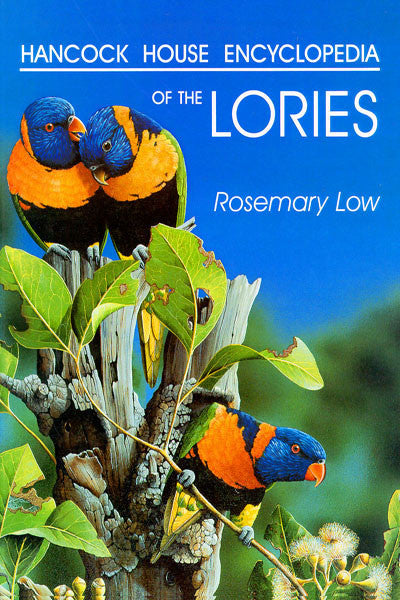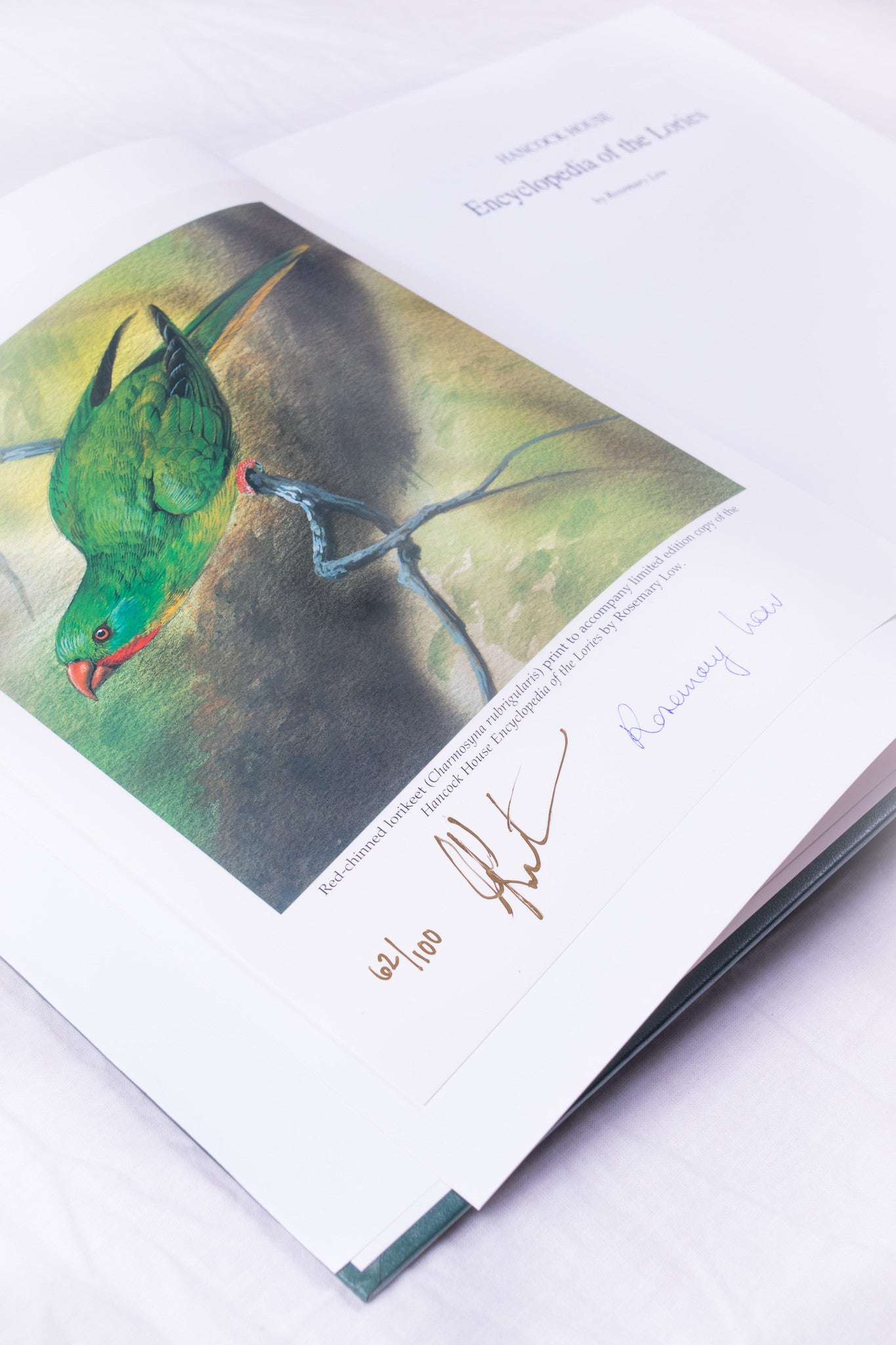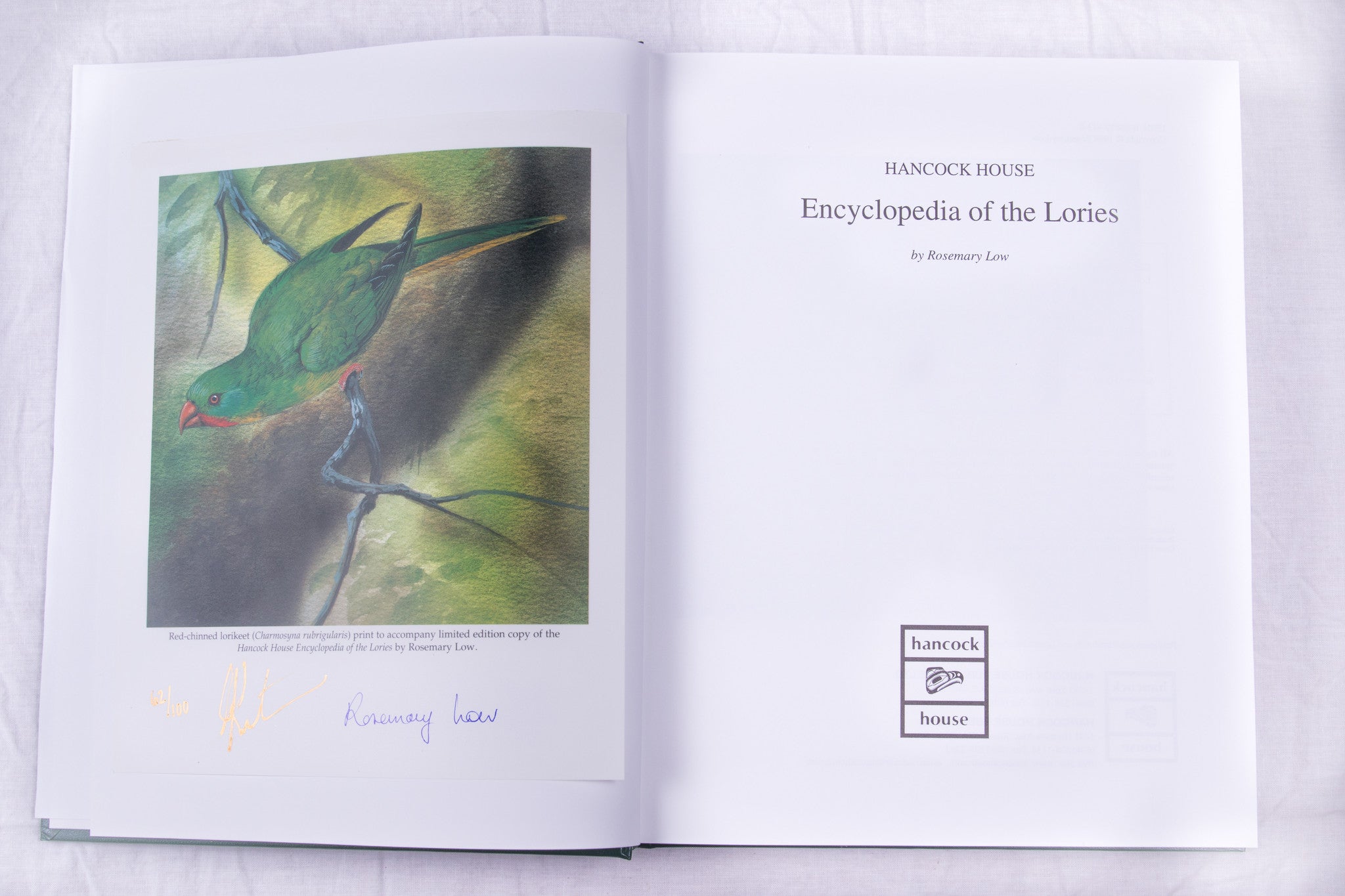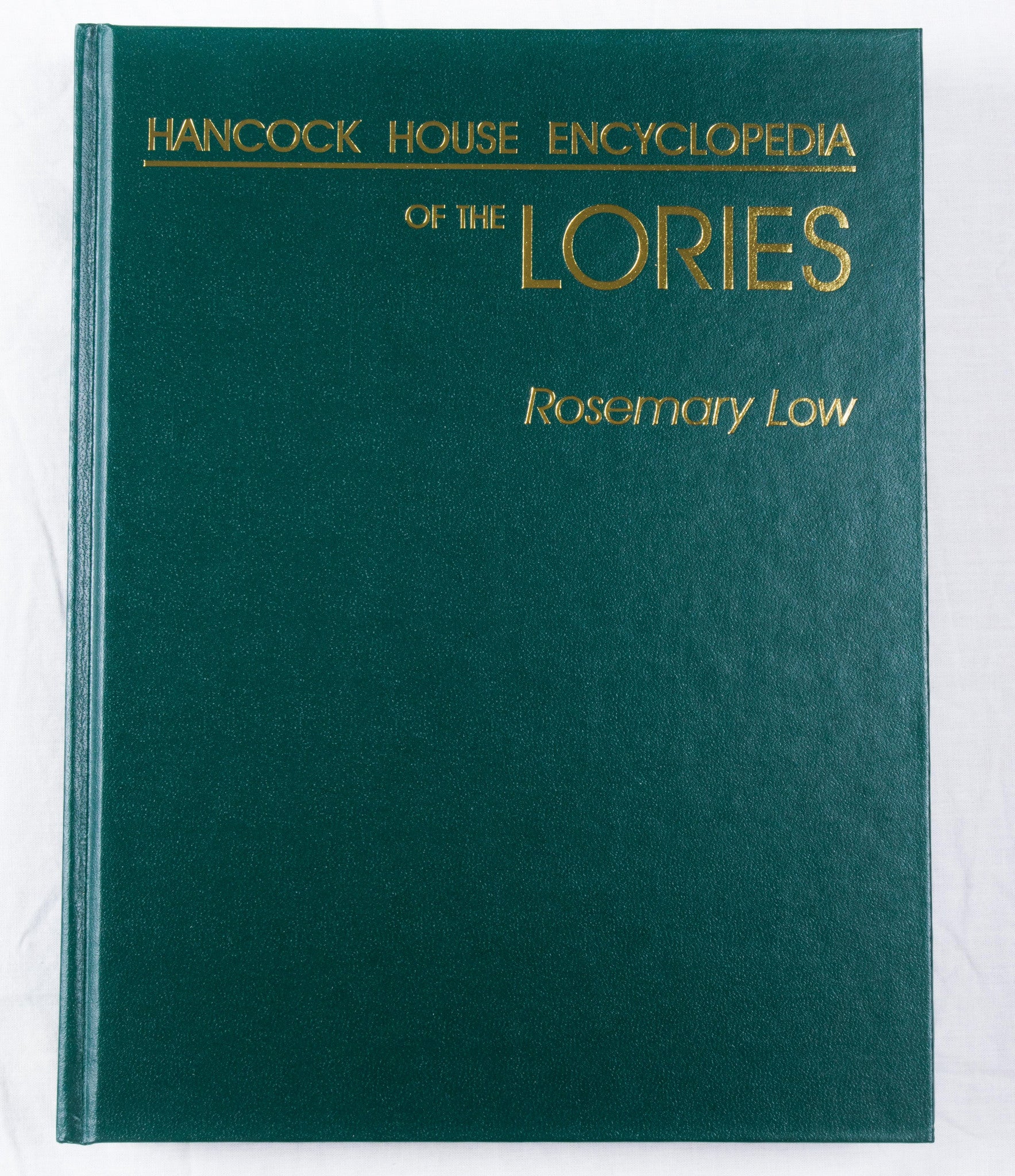




Hancock House Encyclopedia of the Lories
Details
By: Low, Rosemary
ISBN: 9780888394132 HC / 9780888394576 LTD ED
Binding: Trade Cloth
Size: 11" X 8.5"
Pages: 432
Photos: 188
Illustrations: 47
Publication Date: 1998
Description
PR Highlights: A detailed look at the various lory species of parrots.
PHOTO Highlights: 48p color section, 3 illus 43 maps & 75 tables.
Limited Edition includes a signed print of a Red-chinned Lory and numbered by the author.
Description: This title covers the biology, distribution and aviculture of every species of Lory Parrot.
Lories are a group of colorful parrots from Australia, Indonesia and the Pacific region. Mainly nectar and pollen feeders, some species are nomadic, moving around in search of blossoms. Their bright colors and active, and often amusing behavior, make them fascinating subjects for study by bird watchers and bird keepers. Rosemary Low brings together, for the first time, detailed and absorbing information on their natural habits and aviculture. Rosemary has arranged this most comprehensive book to give immediate access to specific subjects and species. The first part is an encyclopedia covering nearly 100 different subjects from aviaries to conservation and from folklore to nest sites. In the second part, the biology of every species is described under standard headings which provide detailed descriptions of plumage, chicks, eggs, habitat, conservation, and more. A special gazetteer section includes distribution maps and information on localities where lories occur. The encyclopedia's large reference section is a valuable source of further reading - in the unlikely event there is anything else the reader needs to know.
The book is a riot of color, with 140 color photographs of these stunningly beautiful birds. It will leave the reader wanting to know them in life.
Author Biography:
Rosemary Low has written twenty books on aviculture, mainly on parrots, including the standard reference Parrots, their care and breeding. Her books have been translated into five languages. She has kept birds since childhood, when she bred budgerigars. She has been fascinated by lories and lorikeets since 1971, when she started to keep them. During nine years in the Canary Islands, as curator of two of the world's largest parrot collections, almost all available lory species were in her care.
Rosemary Low has traveled widely, observing lories in the wild and in collections, and speaking at aviculture conventions in many counties. Intensely interested in conservation and the plight of birds in the wild, she has been editor of the World Parrot Trust's magazine PsittaScene, since its inception. She returned to the UK to live in 1995, where she writes for aviculture magazines worldwide and looks after her lory collection.
Book Reviews
Lory Research Group
Review by Devorah A. N. Bennu, Ph.D.
2000
The colorful plumage and playful nature of the Loriinae have attracted attention from many aviculturists and birdkeepers throughout the years. For some, lack of knowledge about the lories has given these birds the reputation as being messy and difficult to keep. Yet, there are some aviculturists who not only admire the lories but know how to raise and care for them in captivity. One such aviculturist is Rosemary Low: few people have done as much as Ms. Low to promote and safeguard the welfare of captive lories. Her latest book, The Hancock House Encyclopedia of the Lories, is the most up-to-date and comprehensive overview of lories yet, providing loriculturists, veterinarians, pet owners and interested others a definitive look at the art and science of keeping and breeding lories. The Encyclopedia, which took ten years to complete, is a 432 page hard cover volume that is printed on high-quality paper. The colorful cover painting, depicting a small family of Red-collared Lorikeets (Trichoglossus haematodus rubritorquis), is by Rachel Lewis. The more expensive collector's edition has a classy forest-green binding emblazoned with the title in gold-colored letters. Each collector's edition is numbered, autographed by the author and includes limited-edition, autographed prints of the Red-chinned Lorikeet (Charmosyna rubrigularis), painted by Gamini Ratnavira. These prints are suitable for framing. The Encyclopedia is divided into four parts. The Alphabetical Listing of Topics includes more than 90 essays on various aspects of lories and lory keeping, such as dietary protein, hand-rearing, breeding problems, ringing (banding), feather plucking and species suitable for beginners. The dietary and feeding sections are especially readable and informative; including some food recipes used by lory breeders in different countries. I also enjoyed the essays about lory tongue structure and the possible relationship between juvenile food-begging calls and lory evolution. The second part, Lory Species Accounts, comprises more than half of the book's length. Compelling and interesting to lory breeders and ornithologists alike, these accounts are updated and entirely rewritten from Ms. Low's earlier lory book (the classic Lories and Lorikeets, 1977). Her writing style is familiar but authoritative, skillfully weaving together personal, avicultural, ornithological and scientific observations into interesting essays about each of the 53 lory species. These species accounts include detailed descriptions of adult and immature birds, subspecies and sexual dimorphisms, followed by a treatise of the natural history of the species and up-to-date avicultural accounts. I was especially interested in the reports of two extinct lory species, described from subfossils found in the Marquesas and Society Islands. This section also includes maps showing each species' natural range. Particularly interesting to lory breeders and pet owners, the species accounts are preceded by a general overview of the genus, describing basic characteristics for the entire genus, such as basic plumage patterns, pet qualities and food preferences. Near the middle of the book are 48 pages of high-quality color photographs depicting many species and subspecies of lories at different ages, including some unusual color mutations and a few species that rarely are depicted in photographs. My personal favorites are the lovely portraits of the White-naped Lory (Lorius albidinuchalis, p. 108) and the Blue-streaked Lory (Eos reticulata, p. 115). Other interesting photographs include a Papuan medicine man wearing a colorful headdress containing lory feathers and a series of pictures detailing the growth and development of a red lory chick from hatching through fledging (p. 118). The drawings are nice, especially Rachel Lewis's drawing of the lorikeet sticking its tongue out of its mouth (p. 154); however, I think this drawing would have been more instructive if several detailed studies of the tongue had been included as insets, particularly since the text mentions structural differences of the tongue between some lory genera. The Encyclopedia of the Lories is the most complete book yet published about the aviculture and natural history of the lories, and anyone interested in lories -- as all parrot lovers ought to be -- should buy and read this book. HIGHLY RECOMMENDED